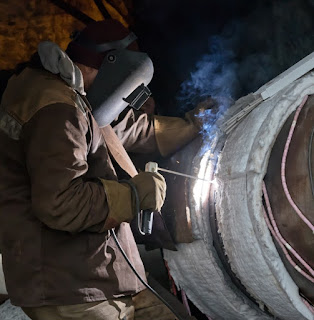From OSHA FactSheet courtesy of Hotfoil-EHS
Welding joins materials together by melting a metal work piece along with a filler metal to form a strong joint. The welding process produces visible smoke that contains harmful metal fume and gas by-products. This article discusses welding operations, applicable OSHA standards, and suggestions for protecting welders and coworkers from exposures to the many hazardous substances in welding fume.
Types of welding
Welding is classified into two groups: fusion (heat alone) or pressure (heat and pressure) welding. There are three types of fusion welding: electric arc, gas and thermit. Electric arc welding is the most widely used type of fusion welding. It employs an electric arc to melt the base and filler metals. Arc welding types in order of decreasing fume production include:
- Flux Core Arc Welding (FCAW) filler metal electrode; flux shield
- Shielded Metal Arc (SMAW) electrode provides both flux and filler material
- Gas Metal Arc (GMAW or MIG) widely used; consumable electrode for filler metal, external gas shield
- Tungsten Inert Gas (GTAW or TIG) superior finish; non-consumable electrode; externally-supplied inert gas shield
Oxy-fuel and plasma cutting, along with brazing, are related to welding as they all involve the melting of metal and the generation of airborne metal fume. Brazing is a metal-joining process where only the filler metal is melted.
What is in welding fume?
Metals: Aluminum, Antimony, Arsenic, Beryllium, Cadmium, Chromium, Cobalt, Copper, Iron, Lead, Manganese, Molybdenum, Nickel, Silver, Tin, Titanium, Vanadium, Zinc.
Gases:
- Shielding—Argon, Helium, Nitrogen, Carbon Dioxide.
- Process—Nitric Oxide, Nitrogen Dioxide, Carbon Monoxide, Ozone, Phosgene, Hydrogen Fluoride, Carbon Dioxide.
- Type of welding process
- Base metal and filler metals used
- Welding rod composition
- Location (outside, enclosed space)
- Welder work practices
- Air movement
- Use of ventilation controls
- Acute exposure to welding fume and gases can result in eye, nose and throat irritation, dizziness and nausea. Workers in the area who experience these symptoms should leave the area immediately, seek fresh air and obtain medical attention.
- Prolonged exposure to welding fume may cause lung damage and various types of cancer, including lung, larynx and urinary tract.
- Health effects from certain fumes may include metal fume fever, stomach ulcers, kidney damage and nervous system damage. Prolonged exposure to manganese fume can cause Parkinson’s–like symptoms.
- Gases such as helium, argon, and carbon dioxide displace oxygen in the air and can lead to suffocation, particularly when welding in confined or enclosed spaces. Carbon monoxide gas can form, posing a serious asphyxiation hazard.
- Chromium is a component in stainless steel, nonferrous alloys, chromate coatings and some welding consumables.
- Chromium is converted to its hexavalent state, Cr(VI), during the welding process.
- Cr(VI) fume is highly toxic and can damage the eyes, skin, nose, throat, and lungs and cause cancer.
- OSHA regulates worker exposure to Cr(VI) under its Chromium (VI) standard, 29 CFR 1910.1026 and 1926.1126.
- OSHA’s Permissible Exposure Limit (PEL) for Cr(VI) is 5 μg/ m3 as an 8-hour time-weighted average.
- Welders should understand the hazards of the materials they are working with. OSHA’s Hazard Communication standard requires employers to provide information and training for workers on hazardous materials in the workplace.
- Welding surfaces should be cleaned of any coating that could potentially create toxic exposure, such as solvent residue and paint.
- Workers should position themselves to avoid breathing welding fume and gases. For example, workers should stay upwind when welding in open or outdoor environments.
- General ventilation, the natural or forced movement of fresh air, can reduce fume and gas levels in the work area. Welding outdoors or in open work spaces does not guarantee adequate ventilation. In work areas without ventilation and exhaust systems, welders should use natural drafts along with proper positioning to keep fume and gases away from themselves and other workers.
- Local exhaust ventilation systems can be used to remove fume and gases from the welder’s breathing zone. Keep fume hoods, fume extractor guns and vacuum nozzles close to the plume source to remove the maximum amount of fume and gases. Portable or flexible exhaust systems can be positioned so that fume and gases are drawn away from the welder. Keep exhaust ports away from other workers.
- Consider substituting a lower fume-generating or less toxic welding type or consumable.
- Do not weld in confined spaces without ventilation. Refer to applicable OSHA regulations (see list below).
- Respiratory protection may be required if work practices and ventilation do not reduce exposures to safe levels.
- Welding, Cutting & Brazing—29 CFR 1910, Subpart Q
- Welding & Cutting—29 CFR 1926 Subpart J
- Welding, Cutting & Heating—29 CFR 1915, Subpart D
- Permit-required confined spaces—29 CFR 1910.146
- Confined & Enclosed Spaces & Other Dangerous Atmospheres in Shipyard Employment—29 CFR 1915 Subpart B
- Hazard Communication—29 CFR 1910.1200
- Respiratory Protection—29 CFR 1910.134
- Air Contaminants—29 CFR 1910.1000 (general industry), 29 CFR 1915.1000 (shipyards), 29 CFR 1926.55 (construction)
For more information on hexavalent chromium exposure, visit OSHA’s website at www.osha.gov.
Article reprinted here courtesy of Hotfoil-EHS.






